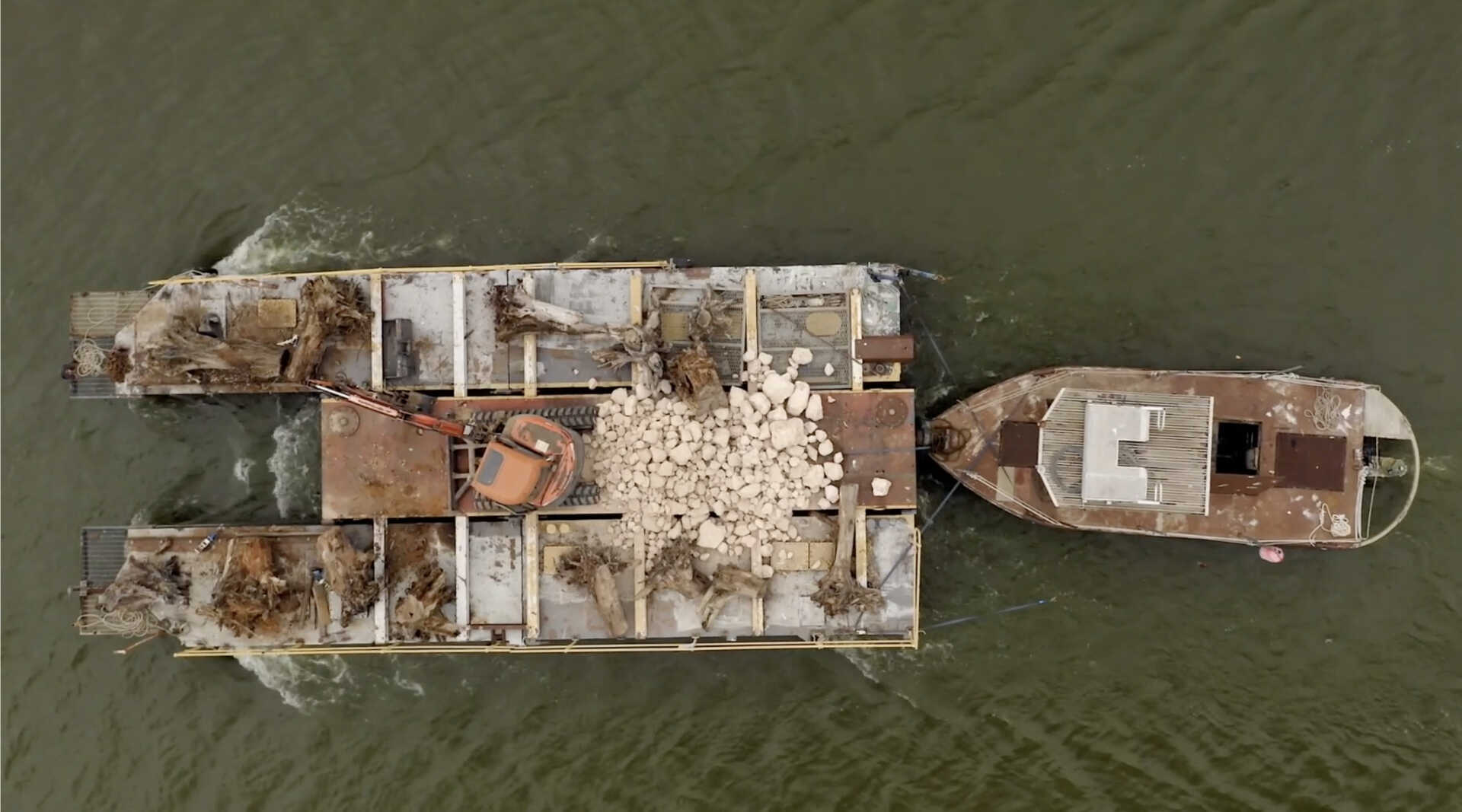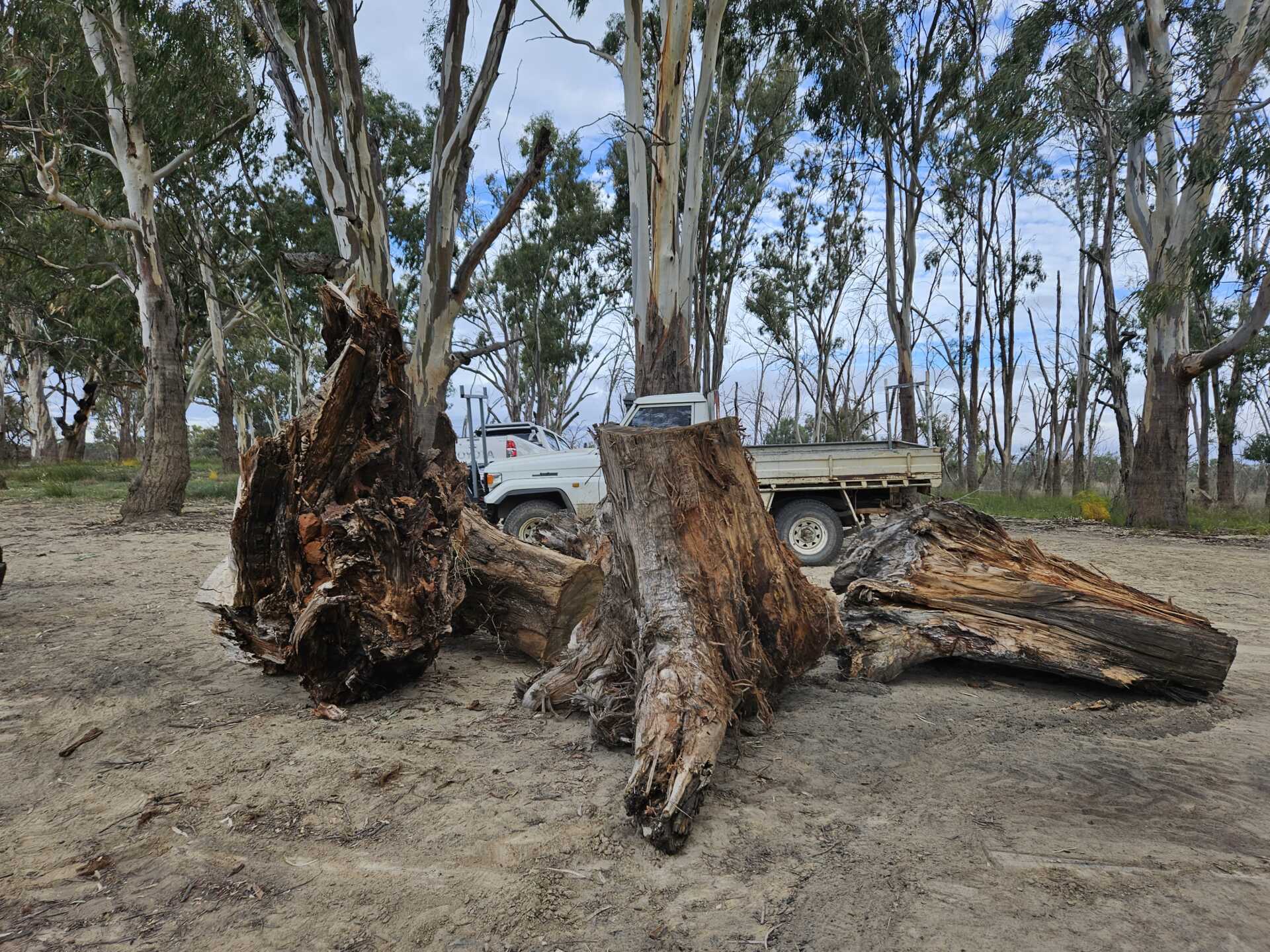Murray-Darling re-snagging project a big win for environment and rec fishers

The latest OzFish Unlimited re-snagging project in the Murray-Darling not only delivers a big win for the environment but will also be a major plus for recreational fishers.
Just like the Murray-Darling itself, OzFish joined two funding streams together to restore some much-needed habitat to the river with volunteers helping to install 20 large logs and 35 tonnes of rock to the Bottle Bend Reserve near the town of Red Cliffs on the Victorian side of the river.
OzFish, Australia’s only fishing charity, was able to complete the project in June thanks to the NSW DPI Fisheries’ Recreational Fishing Trust’s Habitat Action Grant Program and through funding from the Australian Government’s Murray–Darling Healthy Rivers Program.
By using a barge, they were able to minimise environmental damage during the project.
“If you do it from the bank, that can cause environmental impact to the soil as you’ve got large machinery moving around, carrying quite heavy structures, that can dig down into soil and there can be concerns with cultural heritage issues,” said Braeden Lampard, OzFish Senior Program Manager – Murray-Darling Basin.
“When you are restoring the environment, you don’t want to walk away causing more damage. We had large trucks bringing the logs onto the barge and then from the barge, we were able to install the structures at the site.
“So, there was absolutely no environmental or cultural heritage impact to any of the land, which is a bonus.”
The benefits for recreational fishers will be immense. This restoration works will add value to the great initiatives undertaken within the Sunraysia community through OzFish and their River Repair Bus and previous re-snagging efforts downstream.
“At the start of the project we had conversations with the local rec fishers and the area where we ended up choosing to undertake the work is locally known as a good fishing run,” Lampard said.
“Essentially, we dropped the logs and rocks approximately 10 to 20 meters apart to make a good 300-400m run where native fish can now move through that area more safely, to stop and rest and feed.
“A lot of rec fishers know that if you want to capture aquatic species, you’ve got to be within two metres of structure or habitat. So essentially a lot of these fishers see more habitat, they think straight away, more fish, which is what OzFish is all about – more habitat, more fish.
“If the fish like what they see, they can also come back to use those structures for breeding. Our native fish typically don’t like to move in open water or if they do it’s for short periods of time so we’re connecting these habitat areas together.”
Sunraysia OzFish volunteers spent hundreds of hours habitat mapping the Murray River in 2018/19.
“That original work and data is going to keep getting used. OzFish isn’t the type of company to undertake a project and then move on. We want to continue to restore these habitats and continue working on them and further downstream,” Lampard added.
“In a perfect world I would like to undertake these projects every year and then continually keep working downstream and instead of connecting 400 meters you can 1km and another one and another one so all of a sudden you’ve got this really large area of the Murray River were we’ve got some prime habitat, not only for native fish but for rec fishers.”
“And that’s great for the local community, tourism and the environment.”
The Murray River Re-snagging Experiment by the Arthur Rylan Institute has provided robust scientific evidence that this type of large-scale river restoration efforts enhances native fish populations while delivering ecological and recreational fishing benefits to communities.
“Volunteers really enjoyed being out and watching these restoration projects take place,” Lampard said.
“They really do see the benefits of these projects. And there’s that sense of belonging as well. One volunteer said to me that by placing more habitat in the water, it means that my children and grandchildren can catch fish in the future.
“So we’re not only doing it for now but also a lot of us are looking into the future as well and can really clearly see the benefits of what it will bring.”
The installed structures will provide critical breeding sites, shelter and protection from predators, a place to rest, ambush sites and feeding grounds for aquatic species, such as the iconic Murray Cod and Golden Perch populations, as well as freshwater catfish and silver perch.
“Millions of snags have been removed from Australian waterways to improve safe river navigation and because there was once a misconception that snags caused erosion to riverbanks,” Lampard said.
“The effects of de-snagging are long lasting and now many native fish populations have declined.
“Back in the early 1900s it was quite a common practice for the early European settlers along the Murray to be pulling out large logs and blowing up rocky structures to help river access, because the paddle steamers in the rivers were the lifeblood of these towns.
“They didn’t have roads between the towns, and they got sick of the paddle steamers hitting all those logs, so they thought it was a good idea to clean them out. Now it’s quite apparent how much damage that has done to these systems.
“So, we’re righting the wrongs and we’re undertaking extreme restoration projects to benefit the environment.”
This project was funded by the Australian Government’s Murray–Darling Healthy Rivers Program, NSW DPI Fisheries’ Recreational Fishing Trust’s Habitat Action Grant Program and the Australian Government through the CRC Program. The project is also supported by BCF – Boating, Camping, Fishing and the local recreational angling community.



